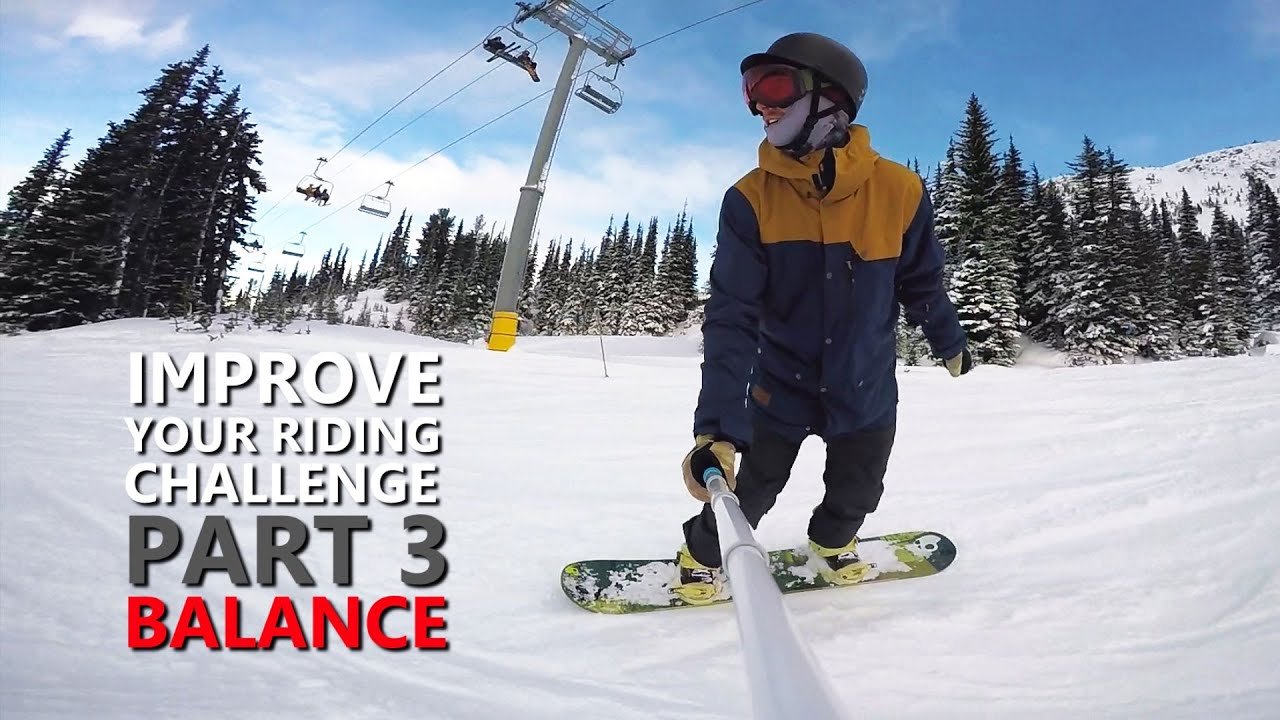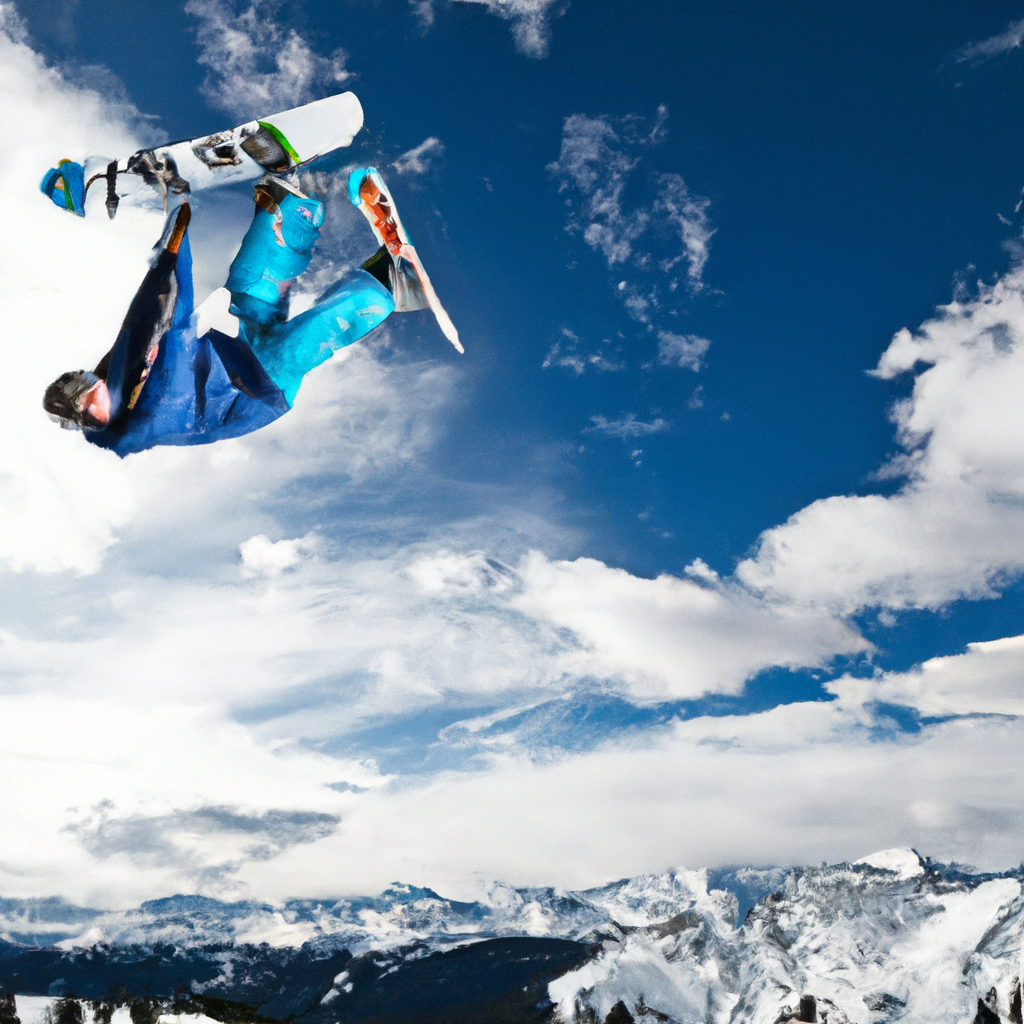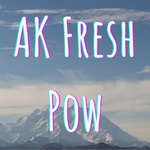
Improve Your Snowboarding Challenge | Part 3 – Balance
In this third installment of the “Improve Your Snowboarding Challenge” series, SnowboardProCamp introduces the concept of balance and how it can be improved through riding with different stances. The foundation of your snowboarding skills lies in your stance on the board, and by experimenting with different positions, you can discover ways to enhance your balance. Whether you choose to ride tall and straight, bend low to the ground, shift your weight forward or backward, or lean over your toes or heels, each variation challenges your balance in a unique way. By trying these different stances, you can gain a better understanding of your own balance and identify any areas for improvement, ultimately enhancing your overall snowboarding experience.
Join Kevin from SnowboardProCamp.com as he guides you through this challenge, emphasizing the importance of stance on your snowboard and how it sets up your balance. By stepping out of your comfort zone and trying different stances, you can evaluate your balance and make necessary adjustments to enhance your snowboarding skills. So take on this challenge, experiment with your stance, and share your experiences and questions in the comments section. Let’s have fun with this challenge and continue to improve our snowboarding abilities together!
Different Stances
Riding tall and straight
Riding tall and straight is a stance that challenges your balance by keeping your body upright and your weight evenly distributed. In this stance, your legs are extended and your back is straight, creating a strong and stable foundation. Riding tall and straight requires core strength and control, as well as proper alignment of your body over the snowboard.
Bending down and riding low
On the other end of the spectrum, bending down and riding low is a stance that requires flexibility and agility. By bending your knees deeply and lowering your center of gravity, you create a more compact and stable position. Riding low allows for better absorption of bumps and changes in terrain, as well as increased control over the snowboard.
Bending at the waist with weight on toes
Another variation is bending at the waist and shifting your weight onto your toes. This stance challenges your balance by distributing more weight onto the front of the snowboard. By bending at the waist, you can experience the feeling of having a majority of your weight over your toes, which requires strong leg muscles and a flexible lower back.
Moving weight back over heels
Moving your weight back over your heels is a stance that shifts the balance towards the back of the snowboard. This stance can be useful in situations where you need more stability and control, such as riding through deep powder or making aggressive turns. However, it requires proper weight distribution and adjustments to maintain balance.
Moving weight forward over nose
The opposite of moving weight back over the heels is moving it forward over the nose of the snowboard. This stance challenges your balance by shifting the majority of your weight towards the front of the board. Moving weight forward over the nose can be beneficial for initiating turns and maneuvers, but it requires careful control and coordination.
Effects on Balance
Understanding how different stances challenge balance
Each of the different stances mentioned above challenges your balance in unique ways. By experimenting with these stances, you can gain a better understanding of how your body responds and adapts to different weight distributions. This understanding helps you identify areas of imbalance and work on improving them.
Feeling the differences in balance
Riding with different stances allows you to feel the differences in balance firsthand. By consciously paying attention to how the different stances affect your body and your control over the snowboard, you can develop a greater kinesthetic awareness. This awareness translates into improved balance and control on the slopes.
Identifying areas of imbalance
While riding with different stances, you may notice certain areas of imbalance or weakness. These areas can manifest as a lack of stability, a loss of control, or difficulty maintaining a particular stance. Identifying these areas of imbalance is crucial for targeted training and improvement. Once you are aware of your weaknesses, you can take steps to address them and strengthen your overall balance.

Benefits of Riding with Different Stances
Improvement in balance
One of the primary benefits of riding with different stances is the improvement in balance. By challenging your balance in various ways, you train your body to adapt and find stability in different situations. This translates into a more confident and stable riding experience overall.
Enhanced control over the snowboard
Additionally, riding with different stances improves your control over the snowboard. As you become more proficient in adjusting your weight distribution and body position, you gain greater control over your movements and maneuvers. This control allows you to navigate challenging terrain and execute advanced techniques with precision.
Increased agility and adaptability
By practicing different stances, you develop increased agility and adaptability on the slopes. You become more comfortable and confident in adjusting your body position and weight distribution to suit different riding conditions. This adaptability is particularly valuable in unpredictable or changing terrain, where quick adjustments are necessary for maintaining balance and control.
Building a strong foundation for advanced maneuvers
Furthermore, riding with different stances builds a strong foundation for advanced maneuvers. The ability to adjust your weight distribution and body position is essential for executing tricks, jumps, and spins. By honing your balance through practicing different stances, you set yourself up for success when progressing to more challenging and technical maneuvers.
Common Mistakes and How to Correct Them
Incorrect weight distribution
One common mistake snowboarders make is incorrect weight distribution. This can manifest as either too much weight on the front foot or too much weight on the back foot, leading to an imbalance and loss of control. To correct this, it is important to focus on maintaining an equal distribution of weight between the front and back foot. This can be achieved through conscious body alignment and adjustments while riding.
Overcompensating with upper body movements
Another mistake is overcompensating with upper body movements. When riders feel off-balance, they may instinctively use excessive upper body movements to regain stability. However, this can actually throw off the balance further and hinder control. The key to correcting this mistake is to focus on using the lower body and core muscles to maintain balance, rather than relying on exaggerated upper body movements.
Lack of flexibility and adaptability
A lack of flexibility and adaptability can also contribute to balance issues. If your body is not able to move and adjust fluidly, it becomes harder to maintain stability on the snowboard. Incorporating regular stretching and flexibility exercises into your routine can help improve your range of motion and overall balance.
Not maintaining a strong core
A strong core is essential for maintaining balance and stability on the snowboard. Neglecting core strength can lead to a lack of control and difficulty executing certain maneuvers. To correct this mistake, focus on incorporating core-strengthening exercises into your training regimen, such as planks, Russian twists, and mountain climbers.
Not practicing regularly
Consistency is key when it comes to improving balance on the snowboard. Not practicing regularly can impede progress and lead to stagnation in your abilities. Make it a point to incorporate regular snowboarding sessions into your schedule, even if it’s just for short periods of time. Regular practice allows for muscle memory to develop and helps solidify your balance skills.

Exercises to Improve Balance
Balance board training
Using a balance board is a great way to improve balance off the slopes. Balancing on a board that mimics the motion of a snowboard challenges your stability and helps develop the necessary muscles and coordination. Start by practicing basic balancing exercises on the board, and gradually increase the difficulty as your skills improve.
One-legged riding
Practicing riding with one leg is an effective exercise for improving balance and control. This exercise challenges your stability and forces you to engage your core and lower body muscles more intensely. Begin by lifting one foot off the snowboard while riding on flat terrain, and gradually progress to riding on one leg while making turns and maneuvers.
Yoga for snowboarders
Yoga is a fantastic complement to snowboarding, as it improves flexibility, balance, and overall body awareness. Incorporating yoga into your training routine can help strengthen the muscles used in snowboarding and enhance your ability to maintain balance on the slopes. Focus on poses that target the legs, core, and balance, such as warrior poses, tree pose, and standing balances.
Core strengthening exercises
As mentioned earlier, a strong core is crucial for maintaining balance on the snowboard. Including specific core-strengthening exercises in your routine can greatly improve your stability and control. Planks, Russian twists, bicycle crunches, and stability ball exercises are all effective for targeting the core muscles used in snowboarding.
Practice riding on different terrains
Another way to improve balance is to practice riding on different terrains. Exposing yourself to varied conditions challenges your balance in different ways and helps you adapt to different slopes and surfaces. Seek out different types of terrain, such as moguls, powder, and groomed runs, and make a conscious effort to maintain balance and control in each.
Tips for Finding Your Optimal Stance
Experiments with different angles and widths
Finding your optimal stance involves experimenting with different angles and widths of your bindings. Start by trying different angles, such as duck stance (with both feet angled outwards) or forward stance (with the front foot angled forward and the back foot angled slightly outward). Additionally, try adjusting the width between your bindings to find the most comfortable and balanced position for your body.
Seeking advice from experienced riders or instructors
If you’re unsure about your optimal stance, seek advice from experienced riders or instructors. They can provide valuable insights and suggestions based on their own experiences and expertise. Consider asking for a stance analysis or participating in a lesson where you can receive personalized feedback on your stance and balance.
Consideration of personal riding style and goals
Always take your personal riding style and goals into consideration when determining your optimal stance. Different stances may be more suitable for specific riding styles or preferences. For example, a rider who focuses on freestyle and park riding may prefer a more centered stance, while a rider who focuses on powder and backcountry riding may prefer a setback stance. Think about your riding style and what feels most comfortable for you.
Regular adjustments and fine-tuning
It’s important to remember that finding your optimal stance is not a one-time decision. As you progress and your riding style evolves, you may find that adjustments need to be made. Regularly reassess your stance and be open to fine-tuning it based on your changing needs and preferences.
Safety Precautions
Start with easier challenges and progress gradually
When incorporating new balance challenges into your snowboarding practice, start with easier challenges and progress gradually. Pushing beyond your current ability level too quickly can increase the risk of falls and injuries. Gradually increase the difficulty and intensity of your balance exercises as your skills and confidence improve.
Wear appropriate safety gear
Always wear appropriate safety gear when snowboarding, especially when attempting new balance challenges. Helmets, wrist guards, and impact-resistant clothing can help protect you from injuries in case of a fall. Prioritize your safety and make sure all your gear is in good condition before hitting the slopes.
Ride within your abilities
It’s crucial to ride within your abilities and comfort level. Pushing beyond your limits without proper training or experience can lead to accidents and injuries. Be honest with yourself about your skill level and gradually progress at a pace that allows you to maintain control and balance.
Warm up and stretch before riding
Before hitting the slopes, take the time to warm up and stretch your muscles. A proper warm-up routine helps improve blood flow and flexibility, reducing the risk of strains or pulls. Focus on dynamic movements that activate the muscles used in snowboarding, such as leg swings, arm circles, and torso rotations.
Importance of Practice and Consistency
Regular practice for muscle memory
Regular practice is essential for developing muscle memory and improving balance. The more often you engage in balance exercises and snowboarding sessions, the more your body becomes accustomed to the movements and positions required for maintaining balance. Consistent practice allows your body to adapt and react more efficiently, leading to improved overall balance.
Consistent training to improve balance
Consistency is key in balance training. Incorporating balance exercises into your regular training routine ensures that you are consistently challenging and improving your balance. Set aside dedicated time for balance training, whether it’s on a balance board, through yoga, or practicing one-legged riding. Consistency will yield better results and faster progress.
Patience and perseverance for long-term progress
Improving balance is a gradual process that requires patience and perseverance. Progress may be slow at times, but with consistent practice and a positive mindset, you will see long-term improvements. Embrace the journey and keep pushing forward, even when faced with challenges or setbacks. Remember that every small step counts towards your overall progress.
Seeking Professional Guidance
Taking lessons from certified instructors
One of the best ways to improve your balance on the snowboard is by taking lessons from certified instructors. Instructors can provide valuable feedback, guidance, and personalized exercises to help you overcome specific balance challenges. They can also assist in identifying areas of improvement and provide targeted training strategies.
Joining snowboarding clinics or camps
Joining snowboarding clinics or camps is another option for seeking professional guidance. These programs often focus on specific aspects of snowboarding, such as balance and technique, and provide intensive training with expert instructors. Clinics and camps offer a structured learning environment and an opportunity to connect with like-minded individuals who share the same goals.
Getting personalized feedback and guidance
If you prefer a more individualized approach, consider seeking personalized feedback and guidance from professionals. Some instructors offer one-on-one coaching sessions, allowing for a tailored training experience based on your specific needs and goals. Personalized feedback can greatly accelerate your progress and provide valuable insights into improving your balance.
Conclusion
Improving balance is a crucial aspect of snowboarding that greatly impacts your overall riding experience. By riding with different stances, you challenge your balance and develop a better understanding of your body’s response to different weight distributions. This knowledge allows you to identify areas of imbalance and work on strengthening them.
The benefits of riding with different stances are numerous, including improved balance, enhanced control over the snowboard, increased agility, and the establishment of a strong foundation for advanced maneuvers. However, it’s important to be aware of common mistakes, such as incorrect weight distribution and overcompensating with upper body movements, and take steps to correct them.
Incorporating exercises like balance board training, one-legged riding, yoga, and core strengthening can greatly improve your balance off the slopes. Additionally, experimenting with different angles and widths, seeking advice from experienced riders or instructors, and engaging in regular adjustments and fine-tuning can help you find your optimal stance.
Remember to prioritize safety by starting with easier challenges, wearing appropriate gear, and riding within your abilities. Warm up and stretch before each session to prevent injuries and ensure optimal performance. Consistent practice and training are essential for improving balance, so make it a priority to engage in regular snowboarding sessions and balance exercises.
If you feel the need for professional guidance, consider taking lessons from certified instructors, joining clinics or camps, or seeking personalized feedback. Professional guidance can provide valuable insights, accelerate progress, and help you overcome specific balance challenges.
By embracing the challenge of improving balance and incorporating these strategies into your snowboarding routine, you can enhance your riding skills, build a solid foundation, and enjoy a more confident and controlled experience on the slopes.
